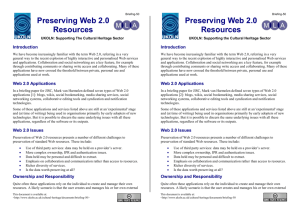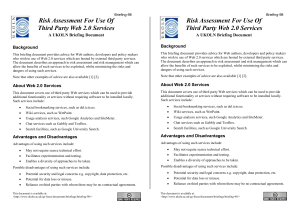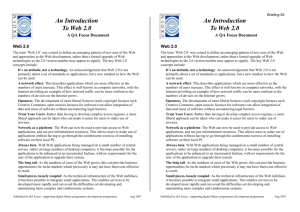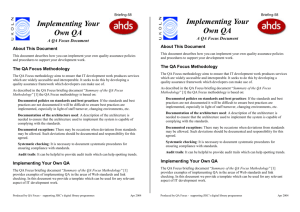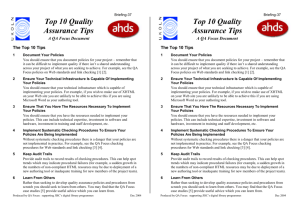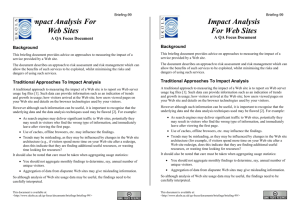Matrix For Selection Of Standards
advertisement
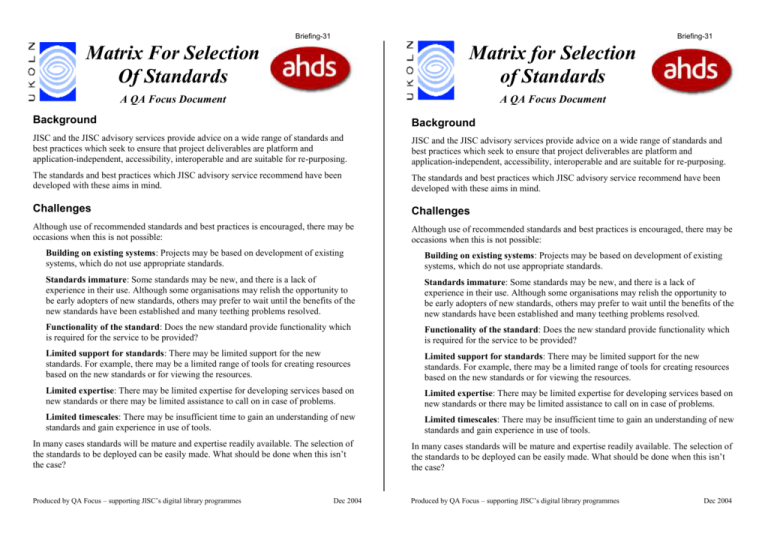
Briefing-31 Briefing-31 Matrix For Selection Of Standards Matrix for Selection of Standards A QA Focus Document A QA Focus Document Background Background JISC and the JISC advisory services provide advice on a wide range of standards and best practices which seek to ensure that project deliverables are platform and application-independent, accessibility, interoperable and are suitable for re-purposing. JISC and the JISC advisory services provide advice on a wide range of standards and best practices which seek to ensure that project deliverables are platform and application-independent, accessibility, interoperable and are suitable for re-purposing. The standards and best practices which JISC advisory service recommend have been developed with these aims in mind. The standards and best practices which JISC advisory service recommend have been developed with these aims in mind. Challenges Challenges Although use of recommended standards and best practices is encouraged, there may be occasions when this is not possible: Although use of recommended standards and best practices is encouraged, there may be occasions when this is not possible: Building on existing systems: Projects may be based on development of existing systems, which do not use appropriate standards. Building on existing systems: Projects may be based on development of existing systems, which do not use appropriate standards. Standards immature: Some standards may be new, and there is a lack of experience in their use. Although some organisations may relish the opportunity to be early adopters of new standards, others may prefer to wait until the benefits of the new standards have been established and many teething problems resolved. Standards immature: Some standards may be new, and there is a lack of experience in their use. Although some organisations may relish the opportunity to be early adopters of new standards, others may prefer to wait until the benefits of the new standards have been established and many teething problems resolved. Functionality of the standard: Does the new standard provide functionality which is required for the service to be provided? Functionality of the standard: Does the new standard provide functionality which is required for the service to be provided? Limited support for standards: There may be limited support for the new standards. For example, there may be a limited range of tools for creating resources based on the new standards or for viewing the resources. Limited support for standards: There may be limited support for the new standards. For example, there may be a limited range of tools for creating resources based on the new standards or for viewing the resources. Limited expertise: There may be limited expertise for developing services based on new standards or there may be limited assistance to call on in case of problems. Limited expertise: There may be limited expertise for developing services based on new standards or there may be limited assistance to call on in case of problems. Limited timescales: There may be insufficient time to gain an understanding of new standards and gain experience in use of tools. Limited timescales: There may be insufficient time to gain an understanding of new standards and gain experience in use of tools. In many cases standards will be mature and expertise readily available. The selection of the standards to be deployed can be easily made. What should be done when this isn’t the case? In many cases standards will be mature and expertise readily available. The selection of the standards to be deployed can be easily made. What should be done when this isn’t the case? Produced by QA Focus – supporting JISC’s digital library programmes Produced by QA Focus – supporting JISC’s digital library programmes Dec 2004 Dec 2004 A Matrix Approach A Matrix Approach In light of the challenges which may be faced when wishing to make use of recommended standards and best practices it is suggested that projects use a matrix approach to resolving these issues. In light of the challenges which may be faced when wishing to make use of recommended standards and best practices it is suggested that projects use a matrix approach to resolving these issues. Area Your Comments Area Standard Standard How mature is the standard? How mature is the standard? Does the standard provide required functionality? Does the standard provide required functionality? Implementation Implementation Are authoring tools which support the standard readily available? Are authoring tools which support the standard readily available? Are viewing tools which support the standard readily available? Are viewing tools which support the standard readily available? Organisation Organisation Is the organisation culture suitable for deployment of new standards? Is the organisation culture suitable for deployment of new standards? Are there strategies in place to continue development in case of staffing changes? Are there strategies in place to continue development in case of staffing changes? Your Comments Individual projects will need to formulate their own matrix which covers issues relevant to their particular project, funding, organisation, etc. Individual projects will need to formulate their own matrix which covers issues relevant to their particular project, funding, organisation, etc. Implementation Implementation This matrix approach is not intended to provide a definitive solution to the selection of standards. Rather it is intended as a tool which can assist projects when they go through the process of choosing the standards they intend to use. It is envisaged that projects will document their comments on issues such as those listed above. These comments should inform a discussion within the project team, and possibly with the project’s advisory or steering group. Once a decision has been made the rationale for the decision should be documented. This will help to ensure that the reasonings are still available if project teams members leave. This matrix approach is not intended to provide a definitive solution to the selection of standards. Rather it is intended as a tool which can assist projects when they go through the process of choosing the standards they intend to use. It is envisaged that projects will document their comments on issues such as those listed above. These comments should inform a discussion within the project team, and possibly with the project’s advisory or steering group. Once a decision has been made the rationale for the decision should be documented. This will help to ensure that the reasonings are still available if project teams members leave. For examples of how projects have addressed the selection of standards see: For examples of how projects have addressed the selection of standards see: ESDS Web Standards Policy, QA Focus case study, <http://www.ukoln.ac.uk/qa-focus/documents/case-studies/case-study-16/> Standards for e-learning: The e-MapScholar Experience, QA Focus case study, <http://www.ukoln.ac.uk/qa-focus/documents/case-studies/case-study-05/> For further information on QA Focus see <http://www.ukoln.ac.uk/qa-focus/> ESDS Web Standards Policy, QA Focus case study, <http://www.ukoln.ac.uk/qa-focus/documents/case-studies/case-study-16/> Standards for e-learning: The e-MapScholar Experience, QA Focus case study, <http://www.ukoln.ac.uk/qa-focus/documents/case-studies/case-study-05/> For further information on QA Focus see <http://www.ukoln.ac.uk/qa-focus/>
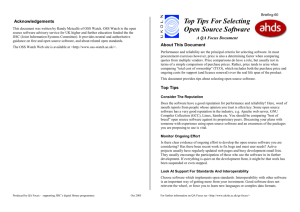
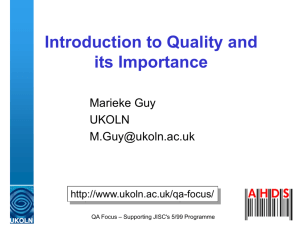
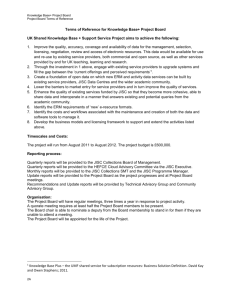
![Selecting_MLEs[1] - Study Net](http://s3.studylib.net/store/data/009211688_1-7ea1360b639a57afdad49a12c2f1e371-300x300.png)

